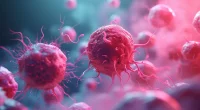Colorectal Cancer – The Disease Explanation
Disease types & epidemiology
How common is the disease?
Colorectal or colon cancer is a disease in which cells in the large intestine grow out of control. Regardless of where the cancer started – in the colon or the rectum – tumors in these locations share a lot in common, which is why they’re together known as colorectal cancer. Colorectal cancer (CRC) predominantly develops as malignant tumors where cells are at first dividing on-site and then spreading in different tissues out of the intestine.
The variety of abnormal cells defines the colorectal cancer type. The most common – 95% – are adenocarcinomas, which arise from glandular epithelial cells. Typical adenocarcinoma takes at least ten years to develop from benign adenoma. However, about 15% of adenocarcinomas are more aggressive in two cases: mucinous adenocarcinoma – 10% of CRC – and signet ring cell adenocarcinoma – 1% of CRC. These tumors may spread rapidly within 2-3 years after appearing and are more challenging to treat.
Rare CRC types – less than 1 % of each kind – are:
- neurons-derived carcinoid tumors called Neuroendocrine Tumors (NET);
- lymphocyte-derived Non-Hodgkin Lymphoma;
- intestinal “pacemaker” cells of Cajal produce rare Gastrointestinal Stromal Tumors (GIST);
- “cancer of smooth muscle in rectum or colon” – Leiomyosarcoma;
- colon and rectal Melanomas from pigmental epithelial cells;
- colorectal squamous cell carcinoma;
- Familial Adenomatous Polyposis (FAP) – a specific inherited condition associated with massive large intestine polyposis from 10-12 years of age.
In the United States, there are 36.6 new cases of CRC per 100,000 men and women per year. According to the National Cancer Institute, about 4.1% of adults will be diagnosed with colorectal cancer at some point in their lifetime.
Causes & risk factors
What is the primary issue of colon cancer?
CRC includes 20-30% hereditary (FAP and Lynch syndrome) and 70-80% spontaneous cases.
The most common scenario for adenocarcinoma CRC development is when epithelial cells undergo a series of genetic or epigenetic changes that enable them to be hyperproliferative – grow fast and spread far. The cancer begins from a tiny benign adenoma in the colorectal segment of the intestine. During the next 10-15 years, under the influence of persistent chronic inflammation from carcinogens and mechanical defects, the adenoma may acquire some cellular damage via pathways of microsatellite instability (MSI) – in 20% of cases – and chromosomal instability (CIN) – 80%.
The cause of CRC is DNA mutations in the inner layer cells of the intestine. Under the influence of genetic damage, bowel epithelium grows uncontrollably. That is a transformation caused by the loss of the tumor suppressor gene APC, which leads tiny adenoma to grow into large but still benign one. Consequently, the activation of KRAS/ BRAF oncogenes and loss of tumor suppressor genes DCC and p53 open a gate of adenoma-to-adenocarcinoma transition through early and late adenoma stages to malignant tumor.
There are two groups of risk factors for the development of CRC: non-modifiable and modifiable. The first group cannot be controlled by individuals, while modifiable risk factors are related to individual habits or lifestyles.
Non-modifiable risk factors for CRC
- Age: most colorectal malignancies manifest at over 50 years. On average, spontaneous colon cancer occurs at 68 years in men and at 72 years in women, while rectal cancer – at 63 years in both genders. Familial forms of CRC develop early in life, with a mean age at diagnosis at roughly 45 years.
- Gender: males tend to be more likely to develop CRC, +87% risk vs women before age 49 and +44% over 50 years old.
- Ethnicity: black men and women have the highest incidence and mortality rates among races, followed by white race, Asians, and American Natives.
- Medical comorbidities: Inflammatory Bowel Disease in medical history triples the chance of developing CRC; with type 2 Diabetes Mellitus (DMt2) the CRC risk is shown to be approximately five times greater than in people with no DMt2.
- Family history of first-degree relatives with CRC is associated with almost two times higher risk compared to no CRC in family background.
- Untreated FAP (APC gene mutation) set 100% lifetime risk of CRC and Lynch syndrome (DNA MMR genes mutation) – 60% risk.
Modifiable risk factors for CRC
- Physical inactivity: an appropriate physical workout reduces the risk of CRC by 24%.
- Obesity: increasing body mass index (BMI) of every 8 kg/m2 adds 10% CRC risk.
- Regular alcohol consumption: the risk of CRC rises by 21% with 2-4 drinks/day (moderate) and 52% with ≥4 drinks/day (heavy).· Cigarette smoking: the risk increases by 6% for 5 pack-years up to 26% for 30 pack-years.
- Eating ≥500 g/week of processed and red meat (beef, pork, lamb) raises CRC risk by 20-30% due to the carcinogenic effects of heme iron molecules.
- People with normal high-fiber dietary patterns, such as vegetables, fruits, whole grains, and cereals, have a 14% decreased risk of CRC development. Conversely, a fiber deficit in consumed food is a moderate risk factor of CRC.
Clinical manifestation & symptoms
What signs should one anticipate while suspecting colorectal cancer?
Colon cancer doesn’t always cause symptoms, especially at first. That’s why screening for those over 45 years old is essential.
The initial symptoms may include:
- a change in bowel habits, such as diarrhea, constipation, or feeling that the bowel does not empty all the way;
- blood in bowel movement (stool);
- frequent abdominal/pelvic pain, aches, or cramps;
- weight loss without known reason.
Diagnostic route & screening
When, where, and how should colorectal cancer be detected?
Regular CRC screening begins for men and women aged 45 years in the U.S. and 50 in Europe. However, persons with familial history of CRC, genetic syndrome (FAP or Lynch syndrome), and inflammatory bowel disease (Crohn’s disease and ulcerative colitis) may proceed to the screening earlier than 45 years old.
The screening gives a person without colorectal tumor symptoms information on possible precancerous polyp so that it can be removed before turning into cancer. It includes:
- guaiac-based fecal occult blood test (gFOBT) or the fecal immunochemical test (FIT) every 2 years – to identify if there is a silent bleeding from a damaged intestinal polyp;
- flexible sigmoidoscopy or colonoscopy every 10 years – to visualize any possible benign adenoma or polyp in the gut.
The screening program is active to age 70-75 years.
If an adult doesn’t follow the screening but presents any symptoms of possible CRC, the tests mentioned above are provided by clinics as diagnostic methods. The diagnosed CRC is classified by the stage of progression and metastasis evidence: from stage 0 (intramucosal carcinoma) through stages I-IIB (the tumor grows into the intestinal wall), then stage IIC-III (the tumor growth into nearby organs by itself or/and spread to 1-7 nearby lymph nodes) and, finally, stage IV (tumor enters liver, lungs, or bones through metastasis).
About 80% of primary CRC diagnoses are patients with stage 0-III tumors, and the remaining 20% are stage IV cancer.
Treatment approaches
What are the options for managing colorectal cancer?
For those CRC lesions which reside locally without lymph nodes and distant organs involvement (stages 0-II), surgical resection of the tumor within a part of the intestine is the primary treatment option. The adjuvant fluorouracil-based (5-FU) chemotherapy for patients with CRC stage II and increased risk of recurrence [the involvement of visceral peritoneum or very abnormal histology] is an option.
Patients with CRC stage III are recommended to receive surgical treatment combined with adjuvant chemotherapy based on one of the following regimes:
- fluorouracil/levamisole (5-FU/LV) OR capecitabine (weaker immunosuppressive adverse effect);
- FOLFOX-4: oxaliplatin/5-FU/LV;
- CAPOX: capecitabine/oxaliplatin.
Stage IV metastatic CRC (mCRC), due to the vast dissemination of secondary lesions, is operable only in 20% of patients whose tumors and metastases can be radically resected. For the rest of mCRC patients, the surgical approach is often combined with palliative chemotherapy to reduce the number and the volume of metastasis.
It is recommended to start with the first-line chemotherapy, such as 5-FU, capecitabine, irinotecan, oxaliplatin, FOLFOXIRI (irinotecan/oxaliplatin/LV/5-FU).
The response rate for the first-line drugs is around 50-54%, leaving roughly half of the patients as a second-line targeted therapy against different cellular factors that support tumor growth:
- bevacizumab (anti-VEGF) combined with FOLFIRI or FOLFOX regime;
- cetuximab (anti-EGFR) alone or combined with FOLFOX/bevacizumab – especially beneficial for KRAS mutation-negative mCRC patients;
- panitumumab (anti-EGFR) combined with FOLFOX-4 – especially beneficial for KRAS mutation-negative mCRC patients;
- aflibercept (anti-VEGF) combined with FOLFIRI;
- ramucirumab (anti-VEGFr2) combined with FOLFIRI;
- trifluridine-tipiracil combined with bevacizumab;
- regorafenib (tyrosine kinase inhibitor);
- encorafenib with cetuximab for BRAF V600E mutations-positive mCRC patients.
The second-line therapy is successful in 20-45% of first-line drug-resistant mCRC patients.
About 4% of mCRC patients have hereditary forms of the disease with specific mutations such as dMMR and MSI-H. For these patient subgroups, immunotherapies were invented. The following drugs are increasing the progression-free survival rate for patients twice better than standard chemotherapy: pembrolizumab (KRAS-negative tumors) and nivolumab/ipilimumab (KRAS-positive tumors).
More than 890 clinics worldwide treat colorectal cancer: https://doctor.global/results/diseases/colorectal-cancer-crc.
Such related procedures as Proctocolectomy are treated in many clinics for an approximate price of:
Prognosis
How does cutting-edge science improve the lifespan and quality of life for those with the disease?
The 5-year relative survival rate for CRC patients is 65%, including 9 out 10 alive patients with stages 0-IIB and 7 out of 10 alive patients with stages IIC-III. The mCRC stage IV is a highly aggressive tumor, which gives a patient, on average, a 3-year 20% and 5-year 10% survival rate if left untreated.
The current diagnostic approach can detect only 40% of CRC cases in the early stages, and the condition might recur following surgery and adjuvant treatment. That’s why regular screening, detecting, and removing polyps at the early stage is crucial; thereby, CRC can be prevented.
You can also find the short explanation of colorectal cancer in the video hereunder:
For more details about colorectal cancer treatment, see the article “Colorectal Cancer – Treatment“.



